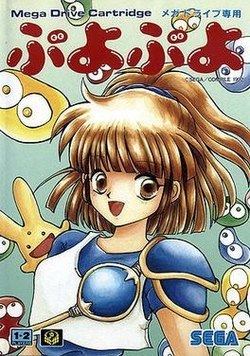Initial release date 25 October 1991 | ||
 | ||
Mode(s) Single-player, multiplayer Platforms Super Nintendo Entertainment System, Nintendo 3DS Publishers Sega, Compile, Banpresto, NEC, Tokuma Shoten, CRI Middleware Co, NEC Avenue, Ltd., Bothtec, Inc., SPS Similar Puyo Puyo games, Compile games, Puzzle video games | ||
Puyo Puyo (ぷよぷよ, Puyo Puyo) is a puzzle video game released in 1991 by Compile for the MSX2. Since its creation, it uses characters from Madou Monogatari. It was created by Masamitsu "Moo" Niitani, the founder of Compile, who was inspired by certain elements from the Tetris and Dr. Mario series of games.
Contents
The game was released by Tokuma Shoten on the same day of the MSX2 release under the name Famimaga Disk Vol. 5: Puyo Puyo (ファミマガディスク Vol.5 ぷよぷよ, Famimaga Disuku Boryūmu Faibu: Puyo Puyo) and as part of the Famimaga Disk series for the Family Computer Disk System. A year after the MSX2 and FDS versions, Sega released an arcade version, which heavily expanded the previous versions by including a one-player story mode and a two-player competitive mode. An English-translated version was created and released internationally which replaces the original voice work, changes many of the characters' names, and removes the wings of the Harpies (which are called Dark Elves in the English version).
Gameplay
The main game of Puyo Puyo is played against at least one opponent, computer or human. The game itself has three modes, Single Puyo Puyo, Double Puyo Puyo, and Endless Puyo Puyo. In Single mode, the player takes on the role of Arle Nadja, a 16-year-old female spellcaster that has the pleasure of foiling Satan's plans. Satan wishes to take over the world, and Arle stands in his way. Arle must first however battle her way through 12 opponents before facing Satan, and unlike Dr Robotnik's Mean Bean Machine, with the exception of Rulue, they are not under Satan's control, nor were they created by him (for Rulue, she fell in love with him). Once Arle has beaten Satan, the world is saved, so she can return home. As in all main Puyo games, the story mode consists of playing Puyo matches against a fixed sequence of characters in one of three courses. In Double mode, two players play against each other. In exactly the same fashion as before, by out-chaining one another, the player tries to fill up their opponent's grid. Since the rules of sending so many garbage blocks made games short-lived, no matter how many chains are sent, Compile added the rule of Sousai in Puyo Puyo TSU and onwards. This lets players counter opponents' attacks with chains of their own, sending any garbage blocks back to them as a result of overflow. In endless mode, the player must continually match puyos to get the highest score they can. In Mission mode, the player must complete 52 missions requiring the Puyos on the field to be eliminated by using limited pieces.
Development
Sega had re-released Puyo Puyo for the Mega Drive on December 18, 1992 and the Game Gear on March 19, 1993 in Japan. Interestingly, the Game Gear port of Puyo Puyo contains an English version named Puzlow Kids; this version appears whenever the game cartridge is used in a North American or European system. A PC-9801 port was released by Compile for the PC-9801 on March 19, 1993, the same day the Game Gear port was released. Tokuma Shoten had re-released their version Puyo Puyo for the Family Computer itself on July 23, 1993, which added a 2-player competitive mode. Banpresto released a version for the Super Famicom under the title Super Puyo Puyo (す〜ぱ〜 ぷよぷよ, Sūpā Puyo Puyo) on December 10, 1993. A port to the Game Boy was developed by Winkysoft, published by Banpresto and released on July 31, 1994 under the original name. NEC released their version of Puyo Puyo for the PC Engine's CD-ROM² on April 22, 1994 titled Puyo Puyo CD (ぷよぷよCD, Puyo Puyo Shī Dī). CRI Middleware released their version of Puyo Puyo for the FM Towns in December 1994.
The game was also ported to Amiga by request of Amiga Power magazine and was featured on a cover disk under the name Super Foul Egg. It was then ported to RISC OS on Acorn by Owain Cole (and featured on an Acorn User cover disk), and finally ported to Java. In late 1995 it was ported to the Apple IIGS by Bret Victor. Before being branded as Puyo Pop internationally, the first game saw release outside Japan in 1993 as Dr. Robotnik's Mean Bean Machine in North America and Europe for the Mega Drive/Genesis as well as the Game Gear and Master System (in Europe and Brazil). Two years later, it was released as Kirby's Avalanche for the Super NES in both North America and Europe.
Legacy
The Mega Drive version was a bestseller in Japan for four months. The Mega Drive version was re-released for the Wii's Virtual Console in Japan on December 2, 2006, while the arcade version was released on April 12, 2011. The arcade VC release features online play.
